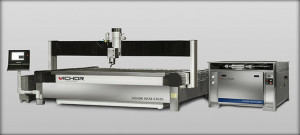
Water Jet Milling Machine: Precision Cutting Without the Heat
In the ever-evolving world of manufacturing and fabrication, the quest for precision, versatility, and material integrity is never-ending. Among the myriad of technologies available, one stands out for its unique approach to material removal: the water jet milling machine. This technology, often simply called waterjet cutting, has revolutionized how we think about machining parts, especially those that are sensitive to high temperatures. But what exactly is it, how does it work, and why should you consider it for your next project? This article dives deep into the world of abrasive water jet milling to provide a clear and comprehensive understanding.
What is a Water Jet Milling Machine?
At its core, a water jet milling machine is a computer-controlled (CNC) tool that uses a very high-pressure stream of water, often mixed with an abrasive garnet sand, to erode material from a workpiece. The term “milling” here is used to describe a specific, precise subtractive manufacturing process. Unlike traditional milling that uses a physical, rotating bit to chip away material, waterjet milling uses this supersonic stream of abrasive fluid to perform detailed cutting, carving, and surface etching.
Think of it as nature’s most powerful power washer, but with unimaginable precision. It can cut through incredibly hard materials like titanium, granite, and tool steel, but is also gentle enough to slice through foam, rubber, and food products without compromising their structure. This incredible range is what makes the water jet milling machine such a valuable asset in modern workshops.
The Core Technology: How a Water Jet Cutter Works
The magic of a water jet milling machine lies in its ability to transform ordinary tap water into a industrial-grade cutting tool. The process can be broken down into a few key stages:
Intensifier Pump: The heart of the system is an ultra-high-pressure pump. This pump uses hydraulic power to pressurize water to extreme levels, typically between 60,000 and 90,000 PSI (4,000 to 6,200 bar). To put that into perspective, a typical pressure washer operates at around 2,000-4,000 PSI.
High-Pressure Tubing: This specially engineered plumbing carries the pressurized water from the pump to the cutting head without any loss of pressure.
Cutting Head & Orifice: The high-pressure water is first forced through a tiny gemstone orifice (usually made of diamond or sapphire) in the cutting head. This orifice focuses the water into a coherent, ultra-thin stream moving at speeds up to three times the speed of sound.
Abrasive Introduction (For Milling): For cutting hard materials, the pure water jet is not enough. Just after the orifice, the stream enters a mixing tube (also called a focusing tube), where a precise amount of granular abrasive material (like garnet) is sucked into the stream via a venturi effect. The water stream accelerates these abrasive particles, turning the mixture into a potent erosive tool that does the actual “milling.”
CNC Control: The entire cutting head is mounted on a gantry system that moves it across the X and Y axes with extreme precision, following a path dictated by a digital CAD file. This allows for incredibly complex and accurate shapes to be cut automatically.
The Unmatched Advantage: Cold Cutting Technology
Perhaps the most significant benefit of using a water jet milling machine is that it is a cold cutting process. Traditional machining methods like laser, plasma, or mechanical milling generate a substantial amount of heat in the workpiece.
No Heat-Affected Zone (HAZ): The heat from lasers and plasma cutters can alter the molecular structure of the material along the cut edge, creating a hardened, brittle area known as the Heat-Affected Zone (HAZ). This can weaken the part and require secondary finishing processes. A water jet generates virtually no heat, eliminating HAZ and preserving the material’s original properties.
No Thermal Stress or Warping: Sensitive materials, especially metals that are already hardened or tempered, can warp or crack under intense thermal stress. Waterjet cutting prevents this entirely, ensuring the final part remains flat and stress-free.
Safe for Heat-Sensitive Materials: This feature opens up possibilities for cutting materials that are highly sensitive to heat, including certain plastics, composites, and laminated materials, which would otherwise melt, burn, or delaminate.
Material Versatility: One Machine for Almost Everything
The versatility of a water jet milling machine is virtually unparalleled in the machining world. Because it is an erosive process rather than a melting or shearing one, it can cut an astonishingly wide range of materials and thicknesses.
Metals: From soft aluminum and copper to super alloys like Inconel, titanium, and hardened tool steel. It handles reflective metals (which are problematic for lasers) with ease.
Stone & Tile: A staple in the countertop and monument industry for intricate designs and precise cuts in granite, marble, and glass.
Composites & Laminates: Ideal for carbon fiber, fiberglass, and honeycomb composites because it cuts without fraying edges or separating layers.
Rubber & Foam: Can cleanly cut through soft, flexible materials without distorting them.
Food Products: Used in the food industry for precise portioning of products like frozen fish, cakes, and poultry without altering taste or texture through heat.
This “one-tool-fits-all” capability makes the water jet milling machine an incredibly efficient and cost-effective solution for job shops and factories that work with diverse materials.

Precision and Capabilities in Detail
Modern water jet milling machine systems are synonymous with high precision. They are capable of holding tolerances within a few thousandths of an inch (±0.003″ to ±0.005″ or better is common) and can produce incredibly intricate details.
Complex Geometries: The narrow kerf (the width of the cut) of a waterjet stream, typically between 0.030″ to 0.050″, allows for cutting very tight radii and complex shapes that would be difficult or impossible with a large mechanical tool.
5-Axis Cutting: Advanced systems feature 5-axis cutting heads that can dynamically tilt. This allows for bevel cutting, tapering, and shaping parts with angled edges in a single setup, a crucial capability for welding preparation and aerodynamic components.
Surface Finishing: By adjusting parameters like pressure, abrasive flow rate, and traverse speed, operators can use the waterjet for more than just cutting through material. It can be used for surface milling, etching textures, and removing coatings without damaging the substrate beneath.
Applications Across Industries
The unique combination of cold cutting, versatility, and precision has led to the adoption of water jet technology in a vast array of industries:
Aerospace: For cutting advanced composites, titanium alloys, and aluminum structures used in aircraft frames and components where material integrity is paramount.
Automotive: Used for prototyping, cutting interior components (like carpets and gaskets), and creating custom body parts from various materials.
Architecture & Art: Creating intricate metal sculptures, detailed inlays for floors, and custom stone countertops with elaborate designs.
Manufacturing: A general workhorse for creating machine parts, tools, and components from virtually any material without the need for tooling changes.
The water jet milling machine is far more than just a cutting tool; it is a versatile, precise, and material-friendly manufacturing solution that addresses the limitations of thermal and mechanical processes. Its ability to cut virtually any material without generating heat-induced defects makes it an indispensable asset in any modern fabrication environment. Whether you are an artist pushing the boundaries of design or an engineer manufacturing mission-critical aerospace components, understanding and leveraging the power of the water jet can open new doors to innovation, efficiency, and unparalleled quality in your work. It truly is a testament to the power of harnessing nature’s simplest element for industrial perfection.
continue reading
Related Posts
- 1371 words6.9 min read
- 1449 words7.3 min read



